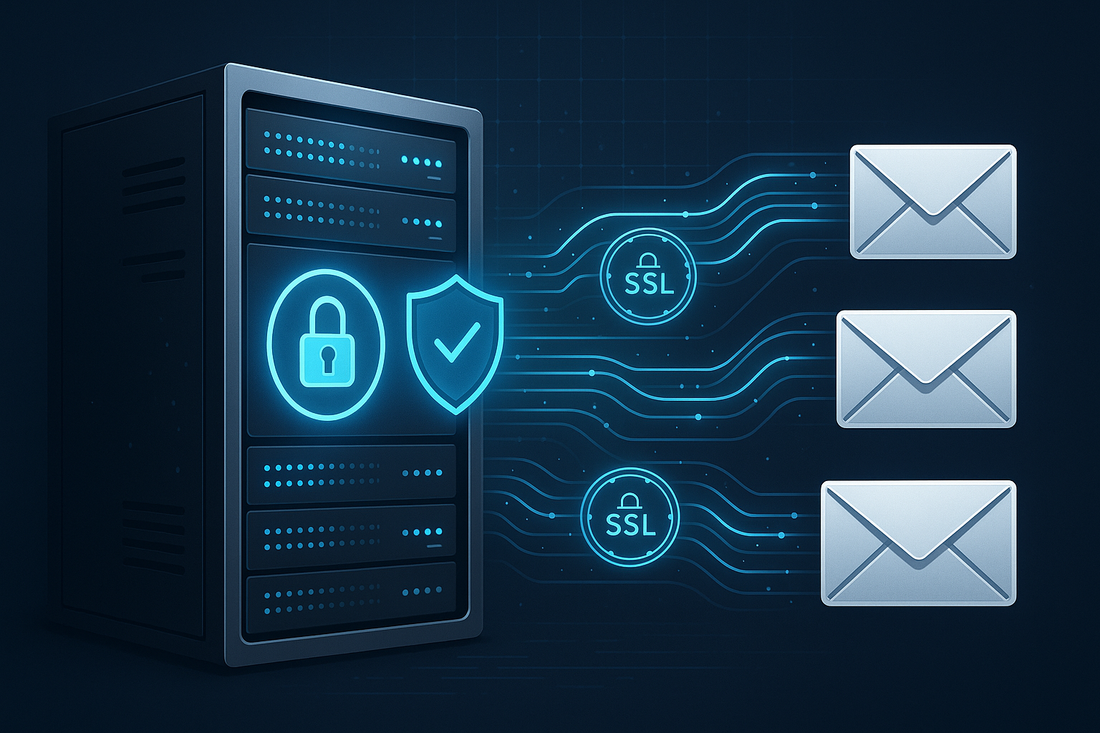
E-Mail Server Security and Encryption
Amanda DavisShare
E-Mail servers handle sensitive communications, confidential documents, and proprietary information daily, making their security a fundamental business requirement.
Proper e-mail server security protects organizational reputation, ensures regulatory compliance, and maintains customer trust. Understanding how to implement SSL Certificates and other security measures is essential for protecting e-mail communications.
Implementing SSL Certificates for E-Mail Server Encryption
SSL Certificates provide encryption that protects e-mail communications during transmission between servers and clients.
When properly implemented, SSL Certificates create secure tunnels for e-mail traffic, preventing unauthorized access to sensitive information. This encryption is essential for protecting data from interception by malicious actors.
E-Mail server SSL Certificate implementation involves configuring multiple protocols including SMTP, POP3, and IMAP.
These protocols, when secured with SSL Certificates, provide protection for all e-mail communications. Modern SSL Certificates support the latest encryption algorithms while maintaining backward compatibility for legacy systems.
Trustico® offers SSL Certificates designed for e-mail server implementations, including Domain Validation (DV), Organization Validation (OV), and Extended Validation (EV) options.
These include support for multiple domain configurations, Wildcard protection, and Subject Alternative Names (SANs), making them suitable for complex e-mail server environments.
S/MIME SSL Certificates for E-Mail Authentication and Signing
Secure/Multipurpose Internet Mail Extensions (S/MIME) provides both encryption and digital signing capabilities for individual e-mail messages.
S/MIME SSL Certificates enable end-to-end e-mail security that protects messages during transmission and while stored in e-mail systems. These specialized SSL Certificates ensure recipients can verify the authenticity of e-mail senders and confirm that messages haven't been tampered with during transit.
Implementing S/MIME SSL Certificates involves installing personal certificates on individual user devices and e-mail clients.
S/MIME creates unique digital signatures for each user, making it virtually impossible for cybercriminals to impersonate legitimate e-mail senders. When combined with encryption capabilities, S/MIME SSL Certificates provide protection against phishing, spoofing, and man-in-the-middle attacks.
S/MIME SSL Certificates support various validation levels, from basic e-mail validation to comprehensive identity verification.
Organization Validation S/MIME SSL Certificates include thorough verification of both e-mail addresses and organizational identity and integrate seamlessly with popular e-mail clients including Microsoft Outlook, Apple Mail, and Mozilla Thunderbird.
Advanced E-Mail Server Firewall Configuration
E-Mail server firewalls represent the first line of defense against malicious e-mail traffic, spam, and potential security threats.
These security systems analyze incoming and outgoing e-mail traffic based on predefined rules and security policies. Effective firewall configuration requires understanding e-mail protocols, traffic patterns, and potential attack vectors that target e-mail servers.
Modern e-mail server firewalls incorporate multiple detection mechanisms including content filtering, reputation-based blocking, and behavioral analysis.
These systems identify and block various types of malicious e-mail content including viruses, malware, phishing attempts, and spam messages. When combined with SSL Certificates, e-mail server firewalls provide protection that addresses both network-level and application-level security threats.
Firewall configuration should include specific rules for SSL Certificate validation.
This ensures that only properly authenticated and encrypted e-mail communications are permitted. SSL Certificates provide the trust anchors and validation mechanisms that enable firewalls to make informed decisions about e-mail traffic legitimacy.
DMARC Implementation for E-Mail Authentication
Domain-based Message Authentication, Reporting, and Conformance (DMARC) helps prevent e-mail spoofing and phishing attacks.
DMARC builds upon existing authentication mechanisms including Sender Policy Framework (SPF) and DomainKeys Identified Mail (DKIM) to provide comprehensive e-mail authentication and reporting capabilities. Proper implementation requires careful configuration of DNS records and authentication policies.
DMARC policies work jointly with SSL Certificates to create multiple layers of e-mail authentication and security.
While SSL Certificates protect e-mail communications during transmission, DMARC policies ensure that e-mail messages originate from authorized sources and haven't been tampered with during transit. This combination provides protection against business e-mail compromise, domain spoofing, and phishing campaigns.
DMARC reporting capabilities provide valuable insights into e-mail authentication failures and potential security threats.
These reports help organizations identify unauthorized use of their e-mail domains and implement appropriate countermeasures. When combined with robust encryption and authentication provided by SSL Certificates, DMARC implementation creates a strong e-mail security framework.
Server Software and Firmware Security Management
Maintaining current server software and firmware versions is fundamental to e-mail server security.
Outdated server software often contains known vulnerabilities that cybercriminals can exploit to gain unauthorized access to e-mail systems. Regular software updates include critical security patches that address newly discovered vulnerabilities and enhance overall system security.
The relationship between server software updates and SSL Certificate functionality is particularly important.
Newer software versions often include enhanced SSL Certificate support, improved encryption algorithms, and better security protocols. Regular updates ensure that your e-mail server can take full advantage of the latest security features and maintain compatibility with evolving SSL Certificate standards.
SSL Certificates maintain compatibility with various server software versions while encouraging adoption of the latest security standards.
Modern SSL Certificates support legacy systems when necessary but provide enhanced security features when deployed on current server software versions. This flexibility ensures organizations can maintain e-mail security during software transition periods.
DNS Blacklist Integration and E-Mail Filtering
Domain Name System Blacklists (DNSBLs), also known as Real-time Blackhole Lists (RBLs), block e-mail communications from known malicious sources.
These systems maintain databases of IP addresses and domains associated with spam, malware distribution, and other malicious activities. Integration of DNSBL services with e-mail server security systems creates an additional layer of protection that complements SSL Certificate-based security measures.
The effectiveness of DNSBL systems depends on regular updates and comprehensive coverage of malicious sources.
Modern DNSBL services utilize multiple data sources including spam traps, honeypots, and security research organizations to identify and categorize malicious e-mail sources. When combined with SSL Certificates, DNSBL integration creates a security framework that addresses both authenticated communications and source reputation verification.
Implementation of DNSBL services requires careful configuration to balance security effectiveness with e-mail delivery reliability.
Overly aggressive DNSBL settings can result in legitimate e-mail being blocked, while insufficient filtering may allow malicious e-mails to reach recipients. SSL Certificates provide the authentication and encryption foundation that enables more sophisticated e-mail filtering decisions.
User Security Training and Multi-Factor Authentication
Human factors represent one of the most significant vulnerabilities in e-mail server security.
Even the most robust SSL Certificate implementations can be compromised if users fall victim to social engineering attacks, use weak passwords, or fail to follow established security procedures. Comprehensive user security training programs address these vulnerabilities by educating employees about e-mail security threats and best practices.
Multi-Factor Authentication (MFA) provides an additional security layer that protects e-mail accounts even when passwords are compromised.
MFA systems require users to provide multiple forms of authentication including passwords, security tokens, biometric data, or mobile device confirmations. When combined with SSL Certificates, MFA creates a robust authentication framework that protects both user accounts and e-mail communications from unauthorized access.
User security controls should include regular password updates, security awareness training, and clear policies regarding e-mail security practices.
Users should understand the importance of SSL Certificate warnings, recognize signs of phishing attempts, and follow established procedures for reporting suspicious e-mail communications. User compliance with security policies ensures that technical protections remain effective in real-world scenarios.
SSL Certificate Lifecycle Management and Renewal
Effective SSL Certificate lifecycle management ensures continuous protection for e-mail server communications without service interruptions.
Proper lifecycle management includes tracking SSL Certificate expiration dates, planning renewal activities, and maintaining continuous security coverage. This prevents the security gaps that can occur when SSL Certificates expire unexpectedly.
The renewal process for e-mail server SSL Certificates requires careful planning to minimize service disruptions.
Trustico® provides tools that include monitoring capabilities, tracking the SSL Certificate status and offering early warnings for SSL Certificates approaching expiration.
SSL Certificate lifecycle management also includes regular security assessments.
These ensure SSL Certificates remain valid. To ensure SSL Certificates support the latest encryption algorithms and security protocols, proper implementation requires ongoing attention to configuration details and security best practices.
Implementing Comprehensive E-Mail Server Security
E-Mail server security requires careful attention to multiple security components including SSL Certificates, authentication protocols, firewall configurations, and user security practices.
SSL Certificates provide the encryption and authentication foundation that enables other security measures to function effectively. This multi-layered approach ensures comprehensive protection against the full spectrum of e-mail security threats.
Trustico® offers SSL Certificate solutions specifically designed for e-mail servers, including S/MIME implementations and Multi Domain environments.
Whether you need basic Domain Validation (DV) SSL Certificates or comprehensive Extended Validation (EV) solutions, proper SSL Certificate implementation provides the security foundation necessary for robust e-mail protection. Combined with proper configuration and ongoing management, SSL Certificates ensure optimal security for critical e-mail communications.





